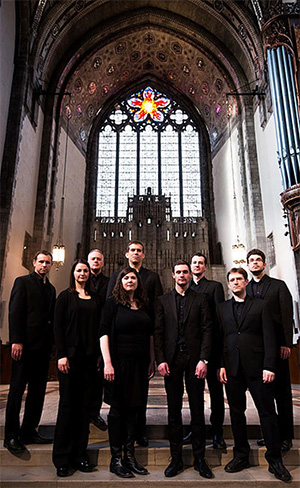by Nicholas Stevens

Listeners number in the hundreds, nodding in appreciation as the researcher who champions the music rises to the podium to explain it, accessibly but not simplistically. On top of all this, the performers sound amazing in the space. Does all this seem too good to be true? Believe it, dear reader: this concert happened in Cleveland on February 21, when Schola Antiqua of Chicago visited St. John’s Cathedral.
Michael Alan Anderson and his group of eight singers — two sopranos, two countertenors, and four spanning tenor to bass ranges, depending on the piece — developed the program in collaboration with Erika Supria Honisch, a musicologist at SUNY Stony Brook and a specialist in the music of Renaissance Prague. The concert, which included a helpful slideshow of period art and manuscripts, gathered beautiful examples of this music under the title Slavic Routes.
The program opened with Stephanie Culica, Laura Lynch, Nolan Carter, Matthew Dean, Keith Murphy, Joe Labozetta, John Orduña, and Joseph Hubbard processing down the aisles while singing the hymn Jesus Christus nostra salus. The chant, intoned with clarity and strength, would become a refrain: sonic glue in a program designed for coherence and followability. Honisch, who along with Anderson periodically popped up to add context, made her case for the music of Prague during the Renaissance, when the city stood as a “Parnassus of the Arts.” Its music reflects that cultural richness.
Vocal grain lent interest to another unaccompanied hymn, Swaty Wáclawe. Then the blossoming of imitative counterpoint in Adrian Willaert’s Haud aliter pugnans fulgebat Caesar highlighted strong voices at either end of the group’s range. As Gaudeamus omnes in Domino rang out, the brilliance of this choice of venue became clear: where else but in a church of St. John’s scale could chant have space to resonate so magnificently?
The most powerful moment of connection between the Renaissance canon and the music of Prague arrived with the pairing of Philippe de Monte’s Super flumina babylonis and William Byrd’s Quomodo cantabimus. The Czech composer had sent his setting of Psalm 137 to Byrd, the text rearranged to suggest the English Catholic composer’s exile in a Protestant land. The sopranos made this gesture of sympathy sound so deeply sincere that the logical next step would involve making Byrd’s radiant affirmation of faith all the more intense. Instead, Anderson let the more famous composer’s intricacies float, quietly assured.
Another pairing linked the Czech hymnodist Jan Hus with the far better-known Martin Luther. Set in opposition, their respective settings of the same text in different languages felt inseparable from their different theologies. A subsequent set brought three Prague composers together for music in praise of Jesus, from Adam Václav Michna’s outward-opening gestures of welcome to Jacobus Gallus’s game of expectation and fulfillment, and on to Franz Sales’s chains of sibilant sounds and resolutions, deftly handled by the ensemble.
The second half began with a set devoted to the relationship between faith, music, and cosmology in Renaissance Europe, captured in Orlandus Lassus’ motet In me transierunt — a tighter relationship than today’s disenchanted science can accommodate. The group’s octave doublings remained pure in another plainchant and hymn. Michna’s motet Radůjte se, ó Čechové left me wondering how the group’s tone could be getting even better over time, and Carl Luython’s Regina coeli provided a blueprint for the singers to trace sonic arcs across the room.
The final set sandwiched Kryštof Harant’s shadowy Qui confidunt in Domino between peppier numbers by Gallus, whose Musica noster amor contains vocal imitations of triumphal trumpet calls — the perfect ending to a concert marked by consummate organization, compelling storytelling, and pristine musicianship.
Published on ClevelandClassical.com March 11, 2020.
Click here for a printable copy of this article

